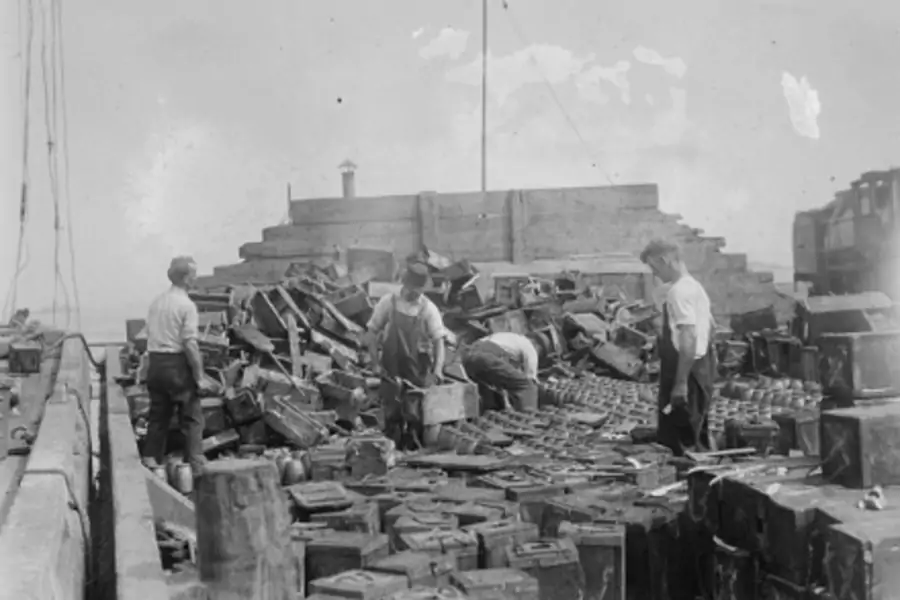The explosion at the Black Tom munitions depot in Jersey City, New Jersey at 2:08 a.m. on Sunday, July 30, 1916 was massive. It generated shockwaves equivalent to a 5.5 magnitude earthquake, blowing out tens of thousands of windows across the harbor in Manhattan. People as far away as Maryland reported being jolted awake. Because of the late hour the death toll was remarkably low; fewer than ten people were killed. Authorities quickly chalked the explosion up to lax safety procedures by the depot’s owner, the Lehigh Valley Railroad, and its operator, the National Dock and Storage Company. Had they known the actual culprit, the United States might have entered World War I eight months sooner than it did—and the outcome of the 1916 presidential election might have been very different.
Black Tom was a busy place in the summer of 1916. The Great War in Europe was nearing the end of its second year. The United States was officially neutral, but U.S. law allowed American weapons manufacturers to sell to anyone who would buy. And business was brisk. Britain and France were the main customers. Germany would have been as well, if not for the British Navy’s blockade of German ports.
More on:
But the munitions business in the early twentieth century was dangerous. Explosions were commonplace. Black Tom had already experienced three of them, though they had been relatively small. Locals thought that the depot was “hoodooed”—or cursed. It didn’t help that safety regulations were routinely ignored, as became clear in the wake of the explosion.
So it’s not surprising that the Jersey City police acted in keeping with the adage “When you hear the sound of hoof beats, think horses, not zebras.” Within twenty-four hours, they had arrested senior officials at the Lehigh Valley Railroad and the National Dock and Storage Company. The possibility of sabotage was immediately dismissed. The chief of the Bureau of Investigation, the forerunner to the FBI, filed a preliminary report noting “our investigator seems to think that the explosion was an accident.” The New York Times reported in its July 31 edition:
On one point the various investigating bodies agree, and that is that the fire and subsequent explosions cannot be charged to the account of alien plotters against the neutrality of the United States.
But the Black Tom explosion had in fact been the work of German saboteurs. They had slipped into the depot after midnight, lit several small fires, and placed time bombs and incendiary devices around the pier. Many of these facts would not come to light until the 1930s, when New York lawyer John McCloy amassed enough evidence to sue Germany at the Mixed Claims Commission at The Hague. In 1939, he won his case, though Adolph Hitler’s government reneged on its pledge to pay. Payment eventually began after World War II, with the final installment being made in 1978. (McCloy went on to become the American High Commissioner in Germany after World War II, and later, president of the World Bank.)
The historical puzzle is why the possibility of German sabotage was dismissed so quickly by almost everyone. Germany had a clear motive: the munitions that left U.S. ports ended up in British and French hands. Moreover, Americans had reason to suspect Berlin. A year earlier, Werner Horn, a German army reserve lieutenant, had been arrested for trying to blow up the international railway bridge at Vanceboro, Maine, which he thought carried Canadian munitions to American ports, and Robert Fay, another German national had been arrested in New Jersey for building bombs to blow up American and neutral ships headed to Europe. Even more puzzling, a month after the explosion, police from nearby Bayonne, New Jersey arrested one of the saboteurs after receiving a tip. The suspect was eventually released for lack of evidence.
More on:
Yet for whatever reason, neither President Woodrow Wilson nor his critics pursued the possibility that Germany might have been responsible. Wilson, a former New Jersey governor, labelled the explosion as “a regrettable incident at a private railroad terminal.” He was more concerned in the summer of 1916 with persuading Britain to relax its blacklist of American firms suspected of trading with Germany. Meanwhile, Charles Evans Hughes, who but for the lack of 4,000 votes in California would have beaten Wilson in the November presidential election, spent much of the summer and fall trying to dispel fears that his election would mean that the United States would join the war in Europe. (Ironically, Hughes formally accepted the Republican presidential nomination the day after the Black Tom explosion with a speech across the Hudson River at Carnegie Hall.) Whether Wilson would have won reelection—and gone on to pursue his vision of a League of Nations—had the American public known that German saboteurs had blown up Black Tom is a great “what if” question to ask.
The Black Tom explosion soon faded from the headlines. War with Germany would come, but not until after Berlin launched unrestricted submarine warfare in 1917 and the American public learned of the Zimmermann Telegram.
Black Tom did have one lasting consequence. Shrapnel from the explosion hit the nearby Statue of Liberty. After the damage was surveyed, it was decided that the public would no longer be allowed access to Lady Liberty’s torch and its spectacular views of New York harbor. The torch has never reopened.
 Online Store
Online Store
